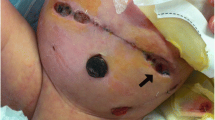Abstract
In Klippel-Trenaunay syndrome surgery is reserved for conditions which result in hemodynamic instability and sepsis. We report a pediatric patient with Klippel-Trenaunay syndrome and life-threatening wound sepsis responding to serial surgical débridements and application of the Vacuum-Assisted Closure device. The device was found to be an effective adjunct to the treatment algorithm.


Similar content being viewed by others
References
Argenta LC, Morykwas MJ (1997) Vacuum-assisted closure: a new method for wound control and treatment: clinical experience. Ann Plast Surg 38:563–570
Baskerville PA, Ackroyd JS, Browse NL (1985) The etiology of Klippel-Trenaunay syndrome. Ann Surg 202:624–635
Berry SA, Peterson C, Mize, W, et al (1998) Klippel-Trenaunay syndrome. Am J Med Genet 79:319–324
Bourde C (1974) Classification des syndromes de Klippel-Trenaunay de Parkes-Weber d'apres les donees angiographiques. Ann Radiol (Paris) 17:153–165
Caprao P, Fisher J, Hammond, D, et al (2002) Klipperl-Trenaunay Syndrome. Plast Reconstr Surg 109:2052–2062
Defranzo AJ, Argenta LC, Marks MW, et al (2001) The use of vacuum-assisted closure therapy for the treatment of lower-extremity wounds with exposed bone. Plast Reconstr Surg 108:1184–1191
Klippel M, Trenaunay P (1900) Du naevus variqueux osteohypertrophique. Arch Gen Med (Paris) 3:611–672
Morykwas MJ, Argenta LC, Shelton-Brown EI, et al (1997) Vacuum-assisted closure: a new method for wound control and treatment: animal studies and basic foundation. Ann Plast Surg 38:553–560
Noel AA, Gloviczki P, Cherry KJ, Rooke TW, Stanson AW, Driscoll DJ (2000) Surgical treatment of venous malformations in Klippel-Trenaunay syndrome. J Vasc Surg 32:840–847
Servelle M, Babillot J (1980) Les malformations des veines profondes dans le syndrome de Klippel et Trenaunay. Phlebologie 33:31–40
Servelle M (1985) Klippel and Trenaunay syndrome: 768 operated cases. Ann Surg 201:365–373
Young AE (1978) Congenital mixed vascular deformities of the limbs and their associated lesions. Birth Defects 14:289–295
Author information
Authors and Affiliations
Corresponding author
Additional information
Conflict of Interest: Wake Forest University receives royalties from KCI (San Antonio, Tex., USA) from the sale and use of the VAC device. Wake Forest University disburses a portion of the royalties to two of the authors (L.C. A. and M.J.M.).
Rights and permissions
About this article
Cite this article
Chung, C.J., David, L.R., Morykwas, M.J. et al. Case review: management of life-threatening sepsis and wound healing in a Klippel-Trenaunay patient using serial surgical débridements and vacuum-assisted closure. Eur J Plast Surg 26, 214–216 (2003). https://doi.org/10.1007/s00238-003-0512-y
Received:
Accepted:
Published:
Issue Date:
DOI: https://doi.org/10.1007/s00238-003-0512-y




